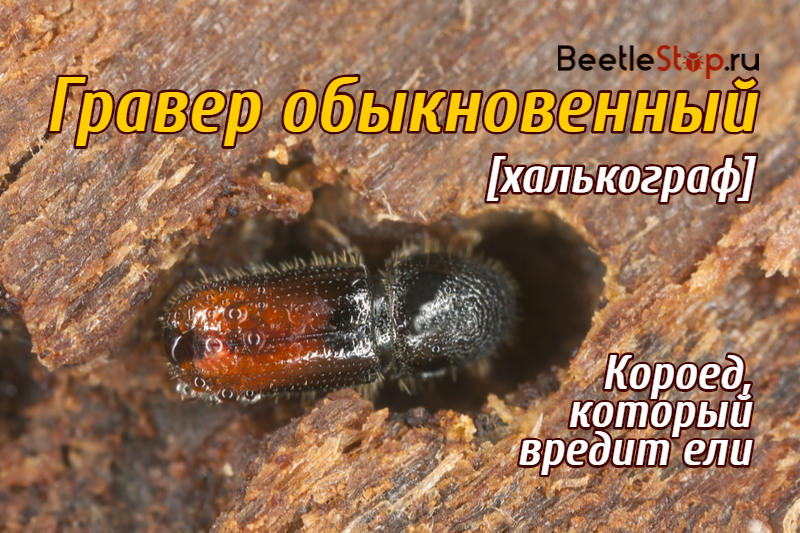Common engraver - coniferous forest pest
Bark beetles are a group of beetles from the family of weevils, consisting of 750 species. Small insects, whose length is 1-9 mm, can cause serious harm to living trees and timber. Beetles prefer conifers. In Europe and Siberia, an ordinary engraver is widespread. The bark beetle specializes in spruce attacking the tops of young trees.

View description
Common engraver or chalcograph (Pityogeneschalcogphus) is a small beetle from the bark beetle subfamily. The body length of the imago is 1.5-2.5 mm. The shape is cylindrical, brown in color, sometimes black. The surface of the pronotum and elytra is glossy, with sparse reddish hairs. The head is small, the shield covers it like a hood. The male’s forehead is flat; the female has a semicircular cavity on the forehead. Antennae short, articulated, club-shaped, brown.
The shield is dark, often black, in front of it is covered with tubercles, the back is punctured. The midline of the pronotum is smooth. Elytra with rows of dots disappearing in the posterior half. On the elytra slope, the beetles have a hollow with tubercles along the edge. This device is called a wheelbarrow and serves to remove drill flour from the course. The male has 3 tubercles equally spaced from each other. In the female, the tubercles are smooth, barely noticeable.
Type name origin
An ordinary engraver was described by Linnaeus in 1761. The scientist called it “chalcogphus”, this word was chosen because of the drawings created by insects on the bark. The constituent parts “chalkos” and “grapho” mean “copper engraving”.
Lifestyle & Reproduction
The chalcograph is found wherever coniferous forests grow. Bark beetles are found in Europe, Siberia, the Caucasus, the Far East and Japan. In Europe, populates trees to Scandinavia and Finland. The number of beetles when moving northward is noticeably reduced. Together with the infected lumber and seedlings, the bark beetle was brought to New Zealand and North America.
In flat forests, the years of beetles begin in April, in the northern regions and mountains in May. The engraver populates trees of various ages, lives on harvested poles and branches. The beetle needs a thin bark, except for spruce, it settles on a pine, fir, larch. The species is polygamous, for each male there are several females. The moves arranged in the cortex have a complex scheme. They include several uterine passages (4-6), their number corresponds to the number of females.
Information. Beetle engraver is a technical pest of wood, its negative impact is enhanced by fungal infection, blue appears on the wood.
During the breeding season, males gnaw through the bark for the device of the mating chamber. Inside, they mate with females. Oblique or horizontal uterine passages depart from the chamber, in which the females leave their eggs. Each round, white, shiny egg is placed in a separate chamber. The appeared larva gnaws at its own passage, which does not exceed 3 cm in length. Their passages are dense, arranged longitudinally, and do not intersect each other. The bark beetles have a specific pattern of moves, according to which scientists determine which species of beetles infected the tree. An ordinary engraver makes moves in the bark, slightly touching the sapwood. The surface wormholes are obtained.
Larvae are white, legless, curved. The body is covered with hairs.The head is clearly visible, painted brown. Larvae move thanks to calluses on the thoracic segments. The offspring succeeds three ages, growing to 2.8 mm. After eating, she arranges a cradle in her bast, in which she pupates. Pupa free, white, with shiny covers. Outwardly similar to an imago.
Young chalcographers appear in late June. They gather in groups for additional nutrition on the cortex. Soon the beetles begin to mate, giving life to the second generation. In the southern regions the third generation has time to appear, the larvae remain to winter.
Interesting fact. Bark beetles clean their passages of drill flour to facilitate their task, they direct the input channels to the ground.
Pest Management Methods
In late May and early June, reconnaissance surveillance of spruce stands is carried out. Signs of pest settlement:
- drips of resin;
- the appearance of drill flour on the barrel;
- color change of needles, needles first turn yellow, then brown;
- detection of bug exit holes;
- peeling the bark by birds.
In July, a sampling of populated trees is carried out. To destroy the pest, debarking and treatment with insecticides is performed before the departure of young adults. An effective preventive measure is to lay out hunting trees in early spring, which are subsequently destroyed along with bark beetles.

